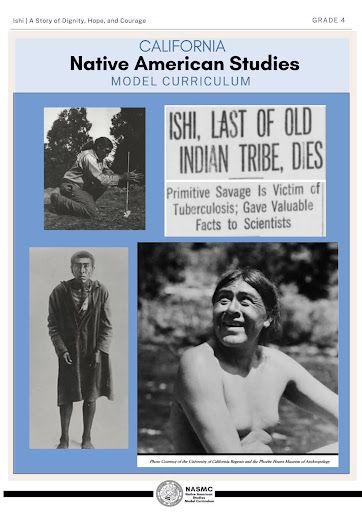Overview
Geography and Survival of the Yahi

Acknowledgment: Resources from this unit and lesson plans come from California Indian Culture and Sovereignty Center.
Ishi: A Story of Dignity, Hope, and Courage Unit (Lesson 2 of 12)
- Lesson 1: Exploring Cultural Values Through Ishi’s Story
- Lesson 2: Geography and Survival of the Yahi
- Lesson 3: Stereotypes and Misrepresentation of Ishi
- Lesson 4: Cultural Practices and Reciprocity
- Lesson 5: Ishi’s Legacy and Repatriation
- Lesson 6: Understanding Cultural Erasure through the Life of Ishi
- Lesson 7: Leadership
- Lesson 8: Romanticizing the Past
- Lesson 9: Phoenix Rising: Ishi’s Experiences in San Francisco
- Lesson 10: Between Science and Sentiment: Ishi’s Treatment in Death
- Lesson 11: Ishi and the Stereotype of the “Last” Yahi
- Lesson 12: Unit Reflection Questions
Grade: 4
Suggested Amount of Time: 60 minutes
Curriculum Themes:
- History
- Cultural Strengths
- Law/Government
- Relationship to Place
- Cross Curricular Integration
Lesson Highlights
- Students will examine how the geography and environment influenced the survival strategies of the Yahi people
- Students will explain the relationship between place and cultural practices in Indigenous communities.
Learning Objectives
- To teach students how physical geography and climate influenced the survival strategies of the Yahi people.
- To develop an understanding of how indigenous communities adapted to their natural environments for sustenance, tools, and shelter.
- To foster analytical thinking by comparing historical and modern resource use.
- To support students to learn and reflect on historical and cultural education about Ishi and the Yahi people.
- To provide students with a deeper appreciation for the life and legacy of Ishi and the broader experiences of Native Californians.
Teacher Background
Essential Understandings of California Indian History and Culture
Essential Understanding 2: Diversity Among Identity (EU2 Video) https://bit.ly/NASMC_EU2
Essential Understanding 3: Native Traditional Beliefs (EU3 Video) https://bit.ly/NASMC_EU3
Essential Understanding 4: Policies that Affected Tribes (EU4 Video) https://bit.ly/NASMC_EU4
Essential Understanding 5: Reservations (EU5 Video) https://bit.ly/NASMC_EU5
Essential Understanding 6: History from a California Indian Perspective (EU6 Video) https://bit.ly/NASMC_EU6
Unit Background
This unit explores the life and legacy of Ishi, the last known member of the Yahi people, as a gateway to understanding Indigenous history, culture, and resilience. Through his story, students investigate the cultural values, survival strategies, and spiritual practices of the Yahi, while critically examining how Ishi has been represented and sometimes misrepresented in history and media. The unit also addresses broader themes of cultural erasure, Indigenous leadership, and the ethical considerations surrounding Ishi’s experiences both in life and after death. By engaging with these topics, students develop empathy and a nuanced appreciation of Indigenous identities, the impact of colonization, and the ongoing efforts toward cultural preservation, repatriation, and justice.
Core Themes:
History and sovereignty
Cultural strengths and Indigenous knowledge systems
Culturally Relevant Terminology
Tribal Nations and Political Identity
Students Will:
Explore the life of Ishi to understand Yahi cultural values, history, and survival practices.
Analyze how geography and environment shaped the Yahi way of life.
Identify and critique common stereotypes and misrepresentations of Ishi in media and historical accounts.
Examine Yahi cultural practices, including language, toolmaking, and ceremonial traditions, with an emphasis on reciprocity.
Reflect on the legacy of Ishi, including ethical issues surrounding repatriation and cultural preservation.
Understand the concept of cultural erasure and its impact on Indigenous communities using Ishi’s story as a case study.
Investigate the forms of Indigenous leadership demonstrated by Ishi and others.
Assess the challenges Ishi faced living in San Francisco and the broader implications of Indigenous survival in settler societies.
Evaluate the treatment of Ishi after death, discussing the balance between scientific inquiry and cultural respect.